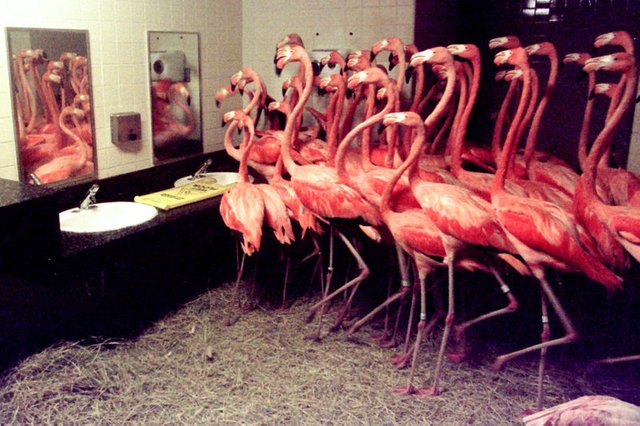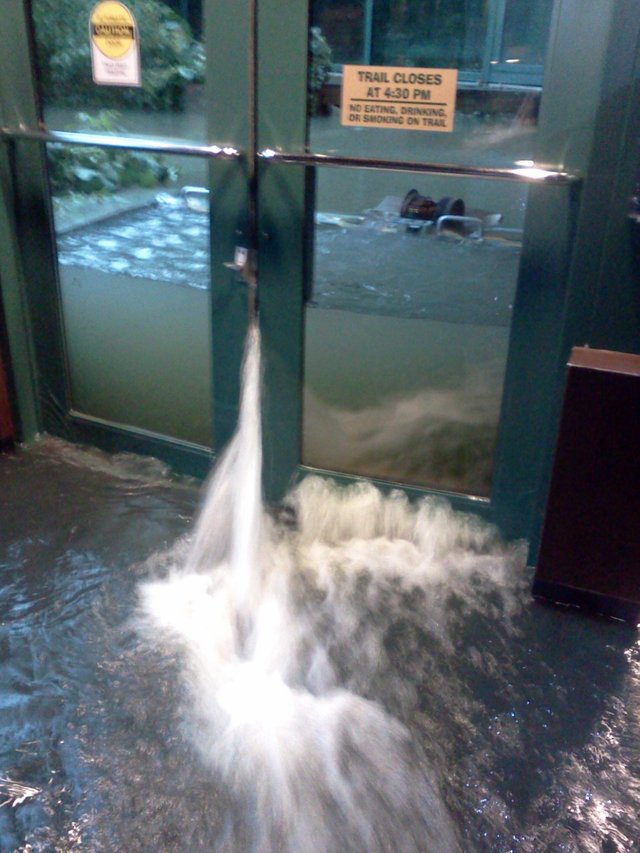What Do Zoos And Aquariums Do In A Hurricane?
As category 5 hurricane Irma moves steadily closer to the southeast coast of United States, millions of people along the coast prepare for the worst. Many states are prepping for mass evacuations and homeowners are rushing to stock up on essentials and prepare their homes for the impending onslaught. As the storm approaches, zoos and aquariums must also prepare to face the hurricane, but they are additionally tasked with caring for hundreds of animals and seeing them safely through the storm. So how do zoos and aquariums prepare for and see through the hurricane?
The number one question I get before a storm is "where are you evacuating the animals to?". The answer? We're not evacuating any of them. In fact, most zoos and aquariums will never evacuate any animals in the face of a hurricane. On the surface, this may seem almost cruel, but there are many reasons that zoos choose not to relocate their collection. First and foremost is the issue of stress; catching animals, restraining them, transporting them to another facility for a short time (only to repeat the process coming back) is likely to be far more stressful for the animal than the storm itself. For many animals, that level of stress can be quite lethal, so for their own safety and comfort, they will remain in their home.
"That's probably the No. 1 question I get asked: 'Oh my God, when are you going to evacuate animals?' We are never going to evacuate animals." - Ron Magill, Zoo Miami communications director Source
There are other factors besides stress that have made that decision. How would we transport all the animals, potentially hundreds or thousands? Where are they going (most zoos don't have room for animals from another facility)? How will they be cared for? By who? How would they be kept separate from the other facility's animals (prevent cross contamination)? And how can you be sure that another facility is going to be any safer?
In preparation for Hurricane Irma this week, Zoo Miami's plan is to stay put, too, says communications director Ron Magill. The reasoning, in part, is because the path of hurricanes can change quickly, and transporting an animal could actually mean moving it into more danger. Source
As the hurricane approaches, animals are moved into appropriate holding areas; smaller birds, mammals and reptiles may be housed in temporary kennels in main buildings, and larger animals bunker down in their normal indoor enclosures. These housing areas are built to withstand just about anything to keep animals and the public safe, and are generally secure places to wait out a hurricane.
"Those night houses are made of poured concrete, welded metal, to withstand the strength of the animal itself. And fortunately, it's also strong enough to withstand the strength of a major hurricane." -Magill Source
The Association of Zoos and Aquariums, typically a very strict organization whose guidelines regulate animal facilities nationwide, actually has very few hurricane procedures, but this is by design. It allows facilities to prepare for these storms in the manner they deem best in order to care for their animal collection. As Murphy's Law states " anything that can go wrong, will go wrong" and zoos and aquariums must be able to adapt to changing conditions to protect animals, regardless of rules or procedures.
We don't necessarily say, 'Here's the plan, just insert your name here. We definitely have guidelines, but we leave it up to each facility to come up with their own plan because each one is unique." - Rob Vernon, AZA spokesman Source
During Hurricane Georges in 1998, Zoo Miami had to house their flamingos in the men's restroom to protect them from the storm (they have actually done this repeatedly with great success).
A team of keepers, a "ride out crew", will remain behind to, as the name implies, ride out the storm. Even if the city orders a mandatory evacuation, this team will hunker down at the facility to keep things running smoothly (animals don't care about weather, they just want to eat!). A maintenance technician will keep the generators running and assist with keeping major pumps and aquatic systems operational, while keepers will prepare food and administer the normal daily care. Regardless of the weather outside, the facility is kept relatively operational (hurricanes, blizzards or even just holidays).
These teams are essential during disasters; when something goes wrong, the team on hand can leap into action to mitigate damage and prevent loss of life. Our own facility was flooded during a storm in 2013 (not even a hurricane, just a summer storm), and water rushed into the museum (we had flood gates installed and the water actually rose OVER the gates, pictured below). Dozens of pumps were fried and shut down compromising aquatic systems, but thanks to the actions of keepers, not a single animal was lost as a result. Repair and reconstruction efforts took over 6 months, but in the end every animal made it through the storm okay!
This was probably my most eventful work day ever!
With Irma bearing down on us there is a lot to worry about, but thanks to dedicated keepers, animals at your local zoo or aquarium will be well taken care of. It will be a rough ride, but they will still be here, happy and healthy, when the clouds part again. So take comfort in knowing your favorite animals are safe, and do what you can to keep yourself and your own family safe as well!
Article Link: http://www.npr.org/






I guess a serious flooding would be the biggest danger. In the photo of the door, you may have 2 ft or a little more, which is not too bad. But if it gets to levels like in Houston or so, it could get very lethal. And also it will cause power outages, propably for a exrented period of time. That would be critical for animals that need heating or water filtering and such, even if they escape the flood water itself.
Well, lets hope things dont get that bad. Evacuation is certainly not a realistic option, except for a few less problematic species, perhaps.
The biggest problem was that all of our pumps are bolted to the floor! The museum was only flooded with about 2 inches of water which might seem insignificant, but it effectively wiped out all our life support systems! I could not imagine how bad it would have been if we had been flooded with FEET of water!
Hi! I like the picture of the flamingos in the bathroom. Too funny!
Have you seen the movie Dolphin Tale? In it, there is a hurricane or some sort of large storm and they leave all of the animals as they are, but they are worried and some people do stay at the aquarium. Great post. Thanks for the information. I hadn't even thought of it!
Not doubting the validity of the article, but due to the severity of the upcoming storm I find it hard to believe that everything will be alright for the zoo and the animals. I'll do my best to stay optimistic, but I can't think of any other alternatives on how to properly evacuate or tend for the animals during natural disasters. Hopefully some developments will be made in the near future.
This one is going to be a major challenge, no doubt there, but it's not going to be anything new for these facilities. The intensity of the storm may be worse, but these zoos and aquariums should be more than alright (actually, Zoo Miami keepers are quite sure of it and they may be in one of the worst spots!). They have faced hurricanes for decades and have finely tuned their procedures in response to what works and what doesn't. With reinforced buildings and all necessary medical and nutritional needs on location, there really isn't much need for any sort of evacuation. The system in place may not seem ideal but it largely works; the animals do make it through the storm healthy and not too stressed out. Zoos affected by hurricane Harvey are already beginning to look towards recovery and have done a fairly remarkable job seeing their animals through the flooding.
Thanks for your post. Do most animals sense inclement weather and generally exhibit survival instincts on their own, or does the protective nature of the zoo's environment make them slightly more lax about the world outside their enclosed environments?
They can definitely sense weather, even species that are kept indoors. Our treefrog exhibit is deep inside our main exhibit building, but the treefrogs can sense pressure changes associated with storms and will often become more active and vocal. Even though our reptile room remains the same temperature year round, our snakes know what season it is and adjust their feeding strategies accordingly.
But they don't really do anything to protect themselves from the storm. The ones that live outdoors are given access to their dens on days with inclement weather so there's no need for them to prepare anything. If it starts raining, all they have to do is go inside and it is nice and warm.
Lesson learned. Thanks for taking the time to explain.
Very interesting article. I would never have imagined a zoo like a place with bunkers and prepared to keep working isolated for several days. I did not know that transport can be so stressful for animals either.
I think the staff that remains in zoos and aquariums in this type of events deserves an applause, and a salary bonus too.
you are a person who think about the animal kingdom in a crisis situation.
It is the quality of our work which will please God and not the quantity.
- Mahatma Gandhi
Thank you for sharing this valuable information, I have always wanted to have a power to have all animals safe when they are in danger
The crocodiles escaping will make a different type of Sharknado movie.